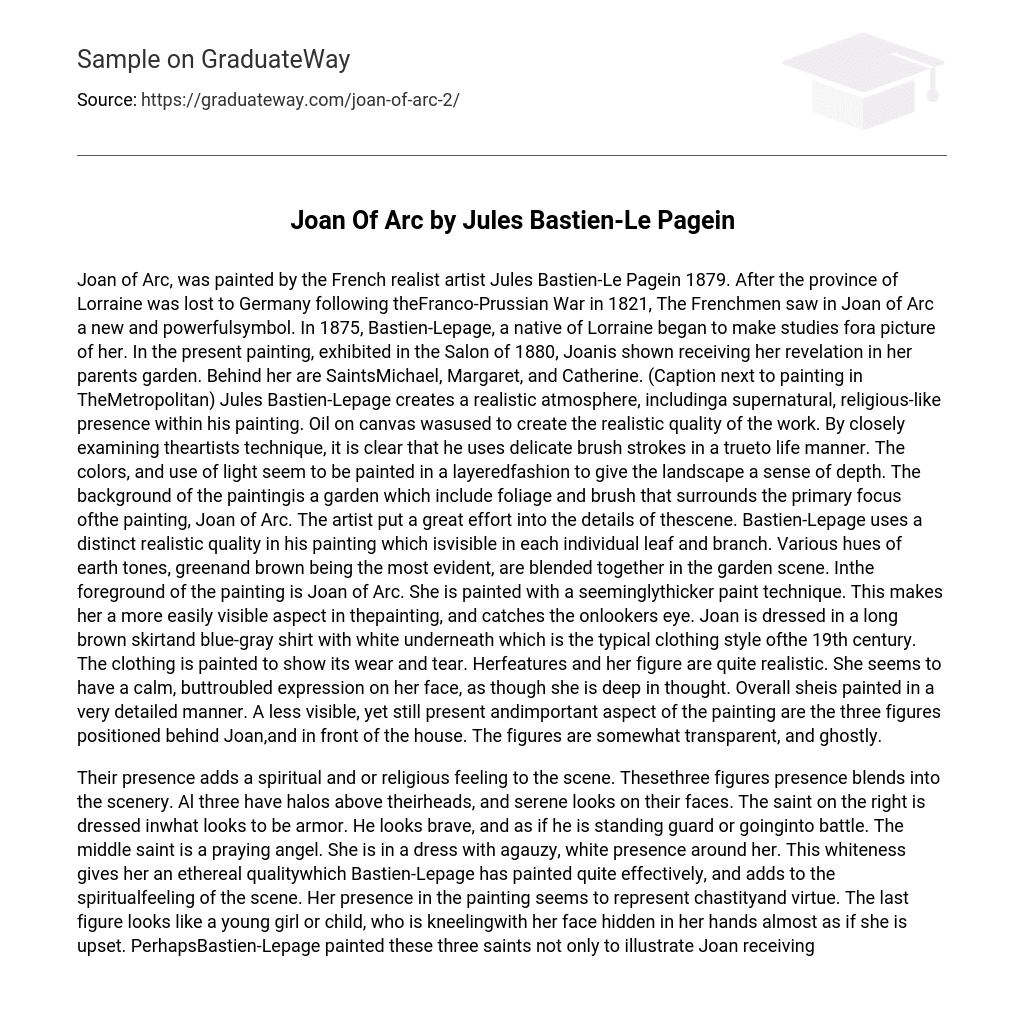Joan of Arc, was painted by the French realist artist Jules Bastien-Le Pagein 1879. After the province of Lorraine was lost to Germany following theFranco-Prussian War in 1821, The Frenchmen saw in Joan of Arc a new and powerfulsymbol.
In 1875, Bastien-Lepage, a native of Lorraine began to make studies fora picture of her. In the present painting, exhibited in the Salon of 1880, Joanis shown receiving her revelation in her parents garden. Behind her are SaintsMichael, Margaret, and Catherine. (Caption next to painting in TheMetropolitan) Jules Bastien-Lepage creates a realistic atmosphere, includinga supernatural, religious-like presence within his painting. Oil on canvas wasused to create the realistic quality of the work. By closely examining theartists technique, it is clear that he uses delicate brush strokes in a trueto life manner.
The colors, and use of light seem to be painted in a layeredfashion to give the landscape a sense of depth. The background of the paintingis a garden which include foliage and brush that surrounds the primary focus ofthe painting, Joan of Arc. The artist put a great effort into the details of thescene. Bastien-Lepage uses a distinct realistic quality in his painting which isvisible in each individual leaf and branch. Various hues of earth tones, greenand brown being the most evident, are blended together in the garden scene.
Inthe foreground of the painting is Joan of Arc. She is painted with a seeminglythicker paint technique. This makes her a more easily visible aspect in thepainting, and catches the onlookers eye. Joan is dressed in a long brown skirtand blue-gray shirt with white underneath which is the typical clothing style ofthe 19th century.
The clothing is painted to show its wear and tear. Herfeatures and her figure are quite realistic. She seems to have a calm, buttroubled expression on her face, as though she is deep in thought. Overall sheis painted in a very detailed manner. A less visible, yet still present andimportant aspect of the painting are the three figures positioned behind Joan,and in front of the house. The figures are somewhat transparent, and ghostly.
Their presence adds a spiritual and or religious feeling to the scene. Thesethree figures presence blends into the scenery. Al three have halos above theirheads, and serene looks on their faces. The saint on the right is dressed inwhat looks to be armor. He looks brave, and as if he is standing guard or goinginto battle.
The middle saint is a praying angel. She is in a dress with agauzy, white presence around her. This whiteness gives her an ethereal qualitywhich Bastien-Lepage has painted quite effectively, and adds to the spiritualfeeling of the scene. Her presence in the painting seems to represent chastityand virtue. The last figure looks like a young girl or child, who is kneelingwith her face hidden in her hands almost as if she is upset. PerhapsBastien-Lepage painted these three saints not only to illustrate Joan receivingher visions, but to illustrate the bravery, religious yet childlike figure thatshe was. Behind Joan of Arc, in the background of the picture is a house.
Bastien-Lepage painted the house so that the masonry is visible. The house seemsto be small in size, plain, and quaint. Surrounding the house is shrubbery,trees, and more of the garden which is seen throughout the painting. Thispainting of Joan of Arc is very significant. Bastien-Lepage is able toeffectively depict Joan as the true heroine that she was. This is significantbecause at the time there were not so many women heroines like her.





